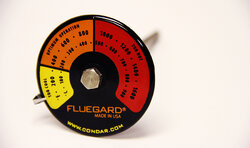I am new to woodstoves, although when I grew up, my parents had one. So total newb here.
My wife and I built a cabin in Northern Lower Michigan this year and installed a new Quadrafire Explorer 2. Luckily, I am not new to firewood as I have always tried to have awesome campfire wood, and as such have a bunch of Oak (seasoned for 4-5 years, stored indoors last 6 months) and Ash (seasoned a year and cut from standing dead due to Ash Bore’s. All the bark had fallen off, so it’s super clean wood). I have also been reading here for at least a year when I was planning, so I know good, dry wood is key which I believe that I have one hand. This stove will be our main heat source, but we do have electric baseboard to keep cabin from freezing as we live downstate and won’t be there except on the weekends and maybe week between Christmas and New Year’s.
Have had a few fires now as it’s been cooling off, but man this thing really burns with a ton of fresh air. I used a duravent pipe straight up thru roof, with a 30-degree offset to get behind the roof ridge. Total flue pipe is about 16-17’. The fire burns great, and the logs have completely burned down, but it seems like there is just a ton of fresh air even with the lever at the min. I have not really loaded it up as it’s not been that cold, but with this much fresh air, there is no way I can see that it would last thru the night.
Is this just how the EPA stoves work these days? Is there anyway to slow the burn down these days? I would really prefer a slower lazy fire, but the air coming in is like a blow torch, lol
I put a couple oak logs in there Friday night and they were gone in less than an hour. Maybe I just need larger splits, as these are probably about 3x4x16 or so, so not huge. The fire is nice to look at as there is a bunch of flame to see thru the glass, but I was really hoping to get an overnight burn on this. Any and all advice is appreciated. We still need to finish the trim and stove, but pic shows general install. Cabin is 24x36 and insulated to current code, was stick built 2x6 sidewalls, and R38 in ceiling.
Thanks,
Eric
Here are a few pics of install and almost final project. Here is the offset thru the trusses.
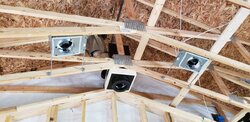
Exterior shot showing the flue, it's about 3' or so above the ridge.
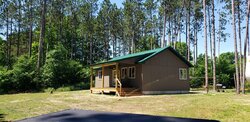
Here was first fire
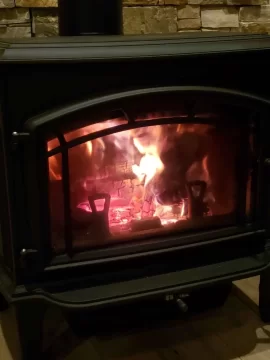
And an interior shot, all flue pipe is double wall.
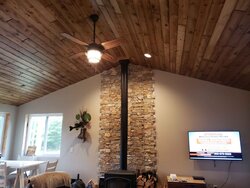
Oh yeah and my woodshed, Oak is inside barn, didn't take a pic of it
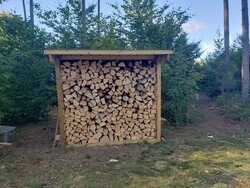
My wife and I built a cabin in Northern Lower Michigan this year and installed a new Quadrafire Explorer 2. Luckily, I am not new to firewood as I have always tried to have awesome campfire wood, and as such have a bunch of Oak (seasoned for 4-5 years, stored indoors last 6 months) and Ash (seasoned a year and cut from standing dead due to Ash Bore’s. All the bark had fallen off, so it’s super clean wood). I have also been reading here for at least a year when I was planning, so I know good, dry wood is key which I believe that I have one hand. This stove will be our main heat source, but we do have electric baseboard to keep cabin from freezing as we live downstate and won’t be there except on the weekends and maybe week between Christmas and New Year’s.
Have had a few fires now as it’s been cooling off, but man this thing really burns with a ton of fresh air. I used a duravent pipe straight up thru roof, with a 30-degree offset to get behind the roof ridge. Total flue pipe is about 16-17’. The fire burns great, and the logs have completely burned down, but it seems like there is just a ton of fresh air even with the lever at the min. I have not really loaded it up as it’s not been that cold, but with this much fresh air, there is no way I can see that it would last thru the night.
Is this just how the EPA stoves work these days? Is there anyway to slow the burn down these days? I would really prefer a slower lazy fire, but the air coming in is like a blow torch, lol
I put a couple oak logs in there Friday night and they were gone in less than an hour. Maybe I just need larger splits, as these are probably about 3x4x16 or so, so not huge. The fire is nice to look at as there is a bunch of flame to see thru the glass, but I was really hoping to get an overnight burn on this. Any and all advice is appreciated. We still need to finish the trim and stove, but pic shows general install. Cabin is 24x36 and insulated to current code, was stick built 2x6 sidewalls, and R38 in ceiling.
Thanks,
Eric
Here are a few pics of install and almost final project. Here is the offset thru the trusses.

Exterior shot showing the flue, it's about 3' or so above the ridge.

Here was first fire

And an interior shot, all flue pipe is double wall.

Oh yeah and my woodshed, Oak is inside barn, didn't take a pic of it

Last edited by a moderator:


